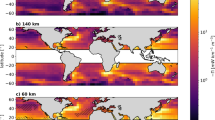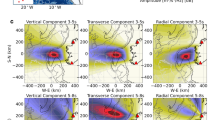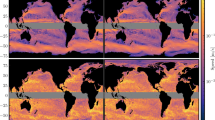Abstract
Observations show that the seismic normal modes of the Earth at frequencies near 10 mHz are excited at a nearly constant level in the absence of large earthquakes1. This background level of excitation has been called the ‘hum’ of the Earth2, and is equivalent to the maximum excitation from a magnitude 5.75 earthquake3. Its origin is debated, with most studies attributing the forcing to atmospheric turbulence, analogous to the forcing of solar oscillations by solar turbulence2,4,5,6,7. Some reports also predicted that turbulence might excite the planetary modes of Mars to detectable levels4. Recent observations on Earth, however, suggest that the predominant excitation source lies under the oceans8,9,10. Here I show that turbulence is a very weak source, and instead it is interacting ocean waves over the shallow continental shelves that drive the hum of the Earth. Ocean waves couple into seismic waves through the quadratic nonlinearity of the surface boundary condition, which couples pairs of slowly propagating ocean waves of similar frequency to a high phase velocity component at approximately double the frequency. This is the process by which ocean waves generate the well known ‘microseism peak’ that dominates the seismic spectrum near 140 mHz (refs 11, 12), but at hum frequencies, the mechanism differs significantly in frequency and depth dependence. A calculation of the coupling between ocean waves and seismic modes reproduces the seismic spectrum observed. Measurements of the temporal correlation between ocean wave data and seismic data9,10 have confirmed that ocean waves, rather than atmospheric turbulence, are driving the modes of the Earth.
This is a preview of subscription content, access via your institution
Access options
Subscribe to this journal
Receive 51 print issues and online access
$199.00 per year
only $3.90 per issue
Buy this article
- Purchase on Springer Link
- Instant access to full article PDF
Prices may be subject to local taxes which are calculated during checkout



Similar content being viewed by others
References
Suda, N., Kazunari, K. & Fukao, Y. Earth’s background free oscillations. Science 279, 2089–2091 (1998)
Nishida, K., Kobayashi, N. & Fukao, Y. Resonant oscillations between the solid Earth and atmosphere. Science 287, 2244–2246 (2000)
Ekstrom, G. Time domain analysis of the Earth’s background seismic radiation. J. Geophys. Res. 106, 26483–26494 (2001)
Kobayashi, N. & Nishida, K. Continuous excitation of planetary free oscillations by atmospheric disturbances. Nature 395, 357–360 (1998)
Nishida, K. et al. Origin of Earth’s ground noise from 2 to 20 mHz. Geophys. Res. Lett. 29 1413 doi: 10.1029/2001GL013862 (2002)
Tanimoto, T. Continuous free oscillations: Atmosphere-solid Earth coupling. Annu. Rev. Earth Planet. Sci. 29, 563–584 (2001)
Fukao, Y. K. et al. A theory of the Earth’s background free oscillations. J. Geophys. Res. 107 (B9)2206 doi: 10.1029/2001JB000153 (2002)
Rhie, J. & Romanowicz, B. Excitation of the Earth’s continuous free oscillations by atmosphere-ocean-seafloor coupling. Nature 431, 552–556 (2004)
Ekstrom, G. & Ekstrom S. Correlation of Earth's long-period background seismic radiation with the height of ocean waves. Eos 86(52), Fall Meet. Suppl. abstr. S34B–02. (2005)
Romanowicz, B., Rhie, J. & Colas, B. Insights into the origin of the Earth’s hum and microseisms. Eos 86(52), Fall Meet. Suppl. abstr. S31A–0271. (2005)
Hasselmann, K. A statistical analysis of the generation of microseisms. Rev. Geophys. 1, 177–209 (1963)
Webb, S. C. Broad seismology and noise under the ocean. Rev. Geophys. 36, 105–142 (1998)
Dahlen, F. A. & Tromp, J. T. Theoretical Global Seismology (Princeton Univ. Press, Princeton, New Jersey, 1998)
Herbers, T. H. C. et al. Infragravity-frequency (0.005–0.05 Hz) motions on the shelf. Part II: Free waves. J. Phys. Oceanogr. 25, 1063–1079 (1995)
Herbers, T. H. C. et al. Generation and propagation of infragravity waves. J. Geophys. Res. 100, (C12)24863–24872 (1995)
Lognonne, P. et al. Computation of seismograms and atmospheric oscillations by normal mode summation for a spherical earth model with a realistic atmosphere. Geophys. J. Int. 135, 388–406 (1998)
Woodhouse, J. H. in Seismological Algorithms, Computational Methods and Computer Programs (ed. Doornbos, D. J.) 321–370 (Academic, London, 1988)
Gaherty, J. B. & Jordan, T. H. Seismic structure of the upper mantle in a central Pacific corridor. J. Geophys. Res. 101, (B10)22291–22309 (1996)
Tanimoto, T. The oceanic excitation hypothesis for the continuous oscillations of the Earth. Geophys. J. Int. 160, 276–298 (2005)
Meecham, W. C. On aerodynamic infrasound. J. Appl. Atmos. Terr. Phys. 33, 149–155 (1971)
Lighthill, J. On sound generated aerodynamically, 1. General theory. Proc. R. Soc. Lond. A 211, 564–587 (1952)
Howe, M. S. Surface pressures and sound produced by turbulent flow over smooth and rough walls. J. Acoust. Soc. Am. 90, 1041–1047 (1991)
Tatom, F. B. & Vitton, S. J. The transfer of energy from a tornado to the ground. Seismol. Res. Lett. 72, 12–21 (2001)
Akhalkatsi, M. et al. Infrasound generation by turbulent convection. Preprint at 〈http://arXiv.org/astro-ph/0409367〉 (v1, 15 Sept., 2004)
Herbers, T. H. C. SAX04 experiment data set 〈http://www.apl.washington.edu/projects/SAX04/summary.html〉 (2006)
Berger, J. et al. Ambient Earth noise: A survey of the Global Seismographic Network. J. Geophys. Res. 109 B11307 doi: 10.1029/2004JB003408 (2004)
Acknowledgements
I thank G. Ekstrom, J. Gaherty and W.W. Webb for discussions, and P. Lognonné and T. Tanimoto for comments and suggestions.
Author information
Authors and Affiliations
Corresponding author
Ethics declarations
Competing interests
Reprints and permissions information is available at www.nature.com/reprints. The author declares no competing financial interests.
Supplementary information
Supplementary Notes
This file contains Supplementary Notes which include a more complete derivation of the equations used in the letter and additional references. (PDF 1924 kb)
Rights and permissions
About this article
Cite this article
Webb, S. The Earth’s ‘hum’ is driven by ocean waves over the continental shelves. Nature 445, 754–756 (2007). https://doi.org/10.1038/nature05536
Received:
Accepted:
Issue Date:
DOI: https://doi.org/10.1038/nature05536
This article is cited by
-
Tools for the efficient analysis of surface waves from active and passive seismic data: exploring an NE-Italy perilagoon area with significant lateral variations
Earth, Planets and Space (2022)
-
Urbanization effect on Hyderabad seismic station
Journal of Earth System Science (2022)
-
Natural and Anthropogenic Sources of Seismic, Hydroacoustic, and Infrasonic Waves: Waveforms and Spectral Characteristics (and Their Applicability for Sensor Calibration)
Surveys in Geophysics (2022)
-
On the Identification of Industrial Components in the Horizontal-to-Vertical Spectral Ratio (HVSR) from Microtremors
Pure and Applied Geophysics (2020)
-
Mars’ Background Free Oscillations
Space Science Reviews (2019)
Comments
By submitting a comment you agree to abide by our Terms and Community Guidelines. If you find something abusive or that does not comply with our terms or guidelines please flag it as inappropriate.



